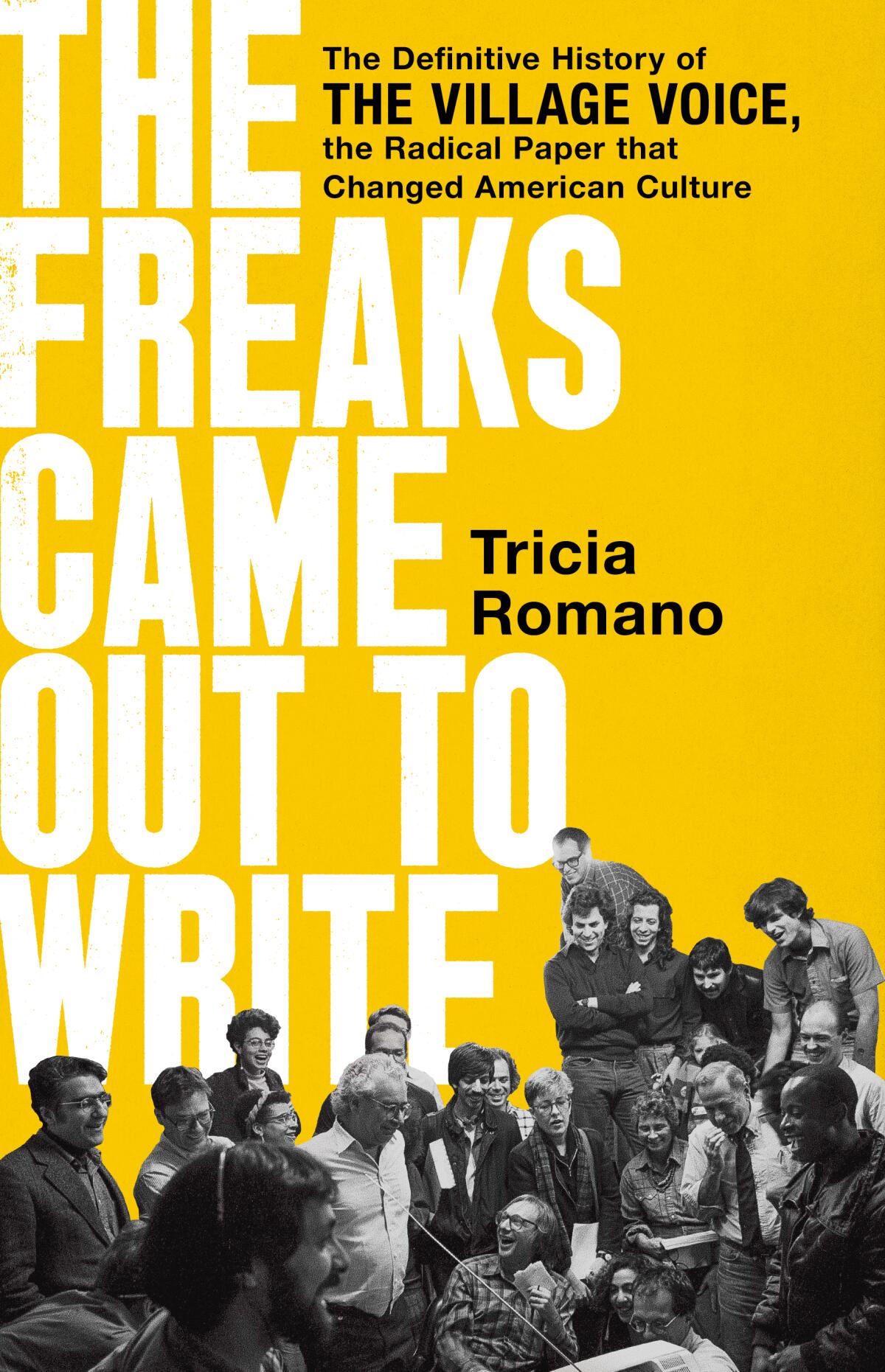The Village Voice gets the rollicking, rebellious oral history it deserves

- Share via
On the shelf
The Freaks Came Out To Write: The Definitive History of the Village Voice, the Radical Paper That Changed American Culture
By Tricia Romano
PublicAffairs: 571 pages, $35
If you buy books linked on our site, The Times may earn a commission from Bookshop.org, whose fees support independent bookstores
While she was the Village Voice’s nightlife columnist in the aughts, Tricia Romano, author of “The Freaks Came Out to Write: The Definitive History of the Village Voice, the Radical Paper That Changed American Culture,” was also working as a DJ in the downtown New York club scene.
Spinning records, it turns out, was an ideal background for preparing this oral history, which is composed of original interviews and archival material mixed to perfection by a writer who knows how to keep a party flowing. In his New York Times review, Dwight Garner said that this “disco ball of a book” might be “the best history of a journalistic enterprise” he’s ever read.
Founded in 1955 by Dan Wolf, Ed Fancher and Norman Mailer, a trio of World War II veterans learning on the fly how to launch a newspaper, the Village Voice was conceived as a combination Greenwich Village bulletin board and speakers forum. The goal was to create a publication capable of keeping pace with a vanguard neighborhood’s extraordinary political and artistic ferment.
From these beginnings, the Voice grew into a cynosure of the counterculture. Rooted in a sensibility defiantly opposed to middlebrow sameness, the paper broadened its scope from a specific urban locale to an ethos no longer confined to a set of quizzically arranged blocks below 14th Street.
A few things set the Voice apart from the start. Wolf, as Diane Fisher, an early staffer, recalls, “was a big believer in amateurism rather than careerism.” In the early days, if you had an ax to grind and knew what you were talking about, you could write a letter that might wind up on the front page. Journalism degrees were considered a liability. Writing skill could be acquired; direct experience and deep investment in a coverage area were harder to come by.
The use of first person was seen as not only liberating but also potentially more honest. Unlike the New York Times, which concealed its ideological convictions under a suit-and-tie façade of objectivity, the Voice was resolutely committed to impassioned advocacy — the more expansively personal, the better.
Jack Newfield, an editor who elevated the Voice’s muckraking, compared his investigative reporting on a story about children who died from lead poisoning to “method acting.” He relied on “sense memory” from his encounters with grieving parents and willfully blind bureaucrats to construct a narrative that would burn the disgraceful truth into public consciousness.
Romano came to the Voice at the tail end of its heyday in the late ’90s, just as the specter of Craigslist was darkening the paper’s future by threatening its goldmine in classified advertising . In a conversation on Zoom, she recalled falling under the Voice’s spell while studying English and journalism at the University of Washington in Seattle. Living in the center of the grunge universe, she was drawn to the roster of great music writers (Ann Powers, who later worked at the Los Angeles Times, Touré and Simon Reynolds, among them). When an internship opportunity came her way, she pounced.

The Voice was perpetually harking back to a better (i.e., more radical) era. I began writing for the paper in the early ’90s and became a senior editor a decade later. Romano’s cubicle was a stone’s throw from my own. We commiserated regularly about the paper’s decline, a staff pastime, but there was an exuberant quality to our gripe sessions. No one needed to remind us how lucky we were to be at a publication that valued writers by paying them a living wage and giving them the freedom to be themselves.
The glory days when Vivian Gornick and Ellen Willis were dissecting the gender politics of everyday life, Stanley Crouch was turning cultural polemics into a new form of jazz and James Wolcott was sharpening his all-purpose critical switchblade may have been over. But trailblazing music critic and editor Robert Christgau was still tuned to the future in a rush of manic annoyance; Nat Hentoff was defending the 1st Amendment from an office that looked like a time bomb had exploded at the Hall of Records; Richard Goldstein was connecting the cultural and political dots with pugnacious empathy; Wayne Barrett (whose Voice reporting and 1991 biography exposed Donald Trump’s nefarious ways) was doggedly untangling the most intricate knots of public corruption; and Lynn Yaeger and Michael Musto were racing out to lunch every afternoon in a plume of Wildean wit and style. Added to the mix were blazing new talents, most notably Ta-Nehisi Coates, ushering the Voice further into the 21st century.
The place was still overrun with eccentrics, but professionalism was institutionalized. Crouch, who is recalled in the book as both a luminous writer and a belligerent colleague, was fired from the Voice in 1988 after getting into a fistfight with another writer. “The two best things that have ever happened to me were being fired by the Voice and being hired by the Voice,” he told the New Yorker.
Most ex-Voicers would agree with the latter. There’s a reason even those who have gone on to more prominent platforms reflect wistfully on their years at the Voice — community. The Voice provided not only intellectual, political and creative camaraderie within the newsroom but it also encouraged critics and reporters to embed themselves in their beats. We didn’t consider ourselves outsiders to the subjects we wrote about or to the readers who responded in the uncensored manner of friends who knew us too well.
Whether it was the Stonewall uprising, the groundswell of second-wave feminism, the birth of off-off-Broadway, the emergence of punk at CBGB or the rise of hip-hop, the Voice was on the scene before a scene had been officially declared. Not that coverage of these areas didn’t entail steep learning curves. But Voice journalists were educating themselves alongside those who were on the front lines of these and other groundbreaking movements.
Community, in its setting of boundaries (this, not that; here, not, there), presupposes a degree of conflict. And no history of the Voice can ignore the litany of ferocious battles that took place inside its headquarters. “The Freaks Came Out to Write” — the title was suggested to Romano by game-changing music writer Greg Tate, who died in 2021 — is organized in a series of short chapters on zeitgeist-shifting moments in the paper’s lifespan.
Romano re-creates through a crisscrossing of interviews the titanic struggles that ensued between the Voice’s largely white, male-dominated news side and the more multicultural roster of arts critics, who were forever migrating from the back pages to the coveted cover. Arts and culture were considered news-making at the Voice, which had the temerity to put on its cover a story I wrote on Lee Breuer’s deconstruction of Ibsen’s “A Doll’s House” with little people.
Writer Robin Reisig recalls Christgau’s remark that everyone in the newsroom would agree that 50% of the Voice was excellent and 50% was awful. The problem was that there was no consensus on which 50% was which. This was true in every era, though the temperature of the disputes had lowered considerably as the 20th century drew to a close.
“There was shouting over cubicles here and there, but the beefs and grudges people had in the ’60s, ’70s and ’80s — a lot of those people were gone by then,” Romano recalled of our overlapping years at the Voice. “And so by the time we arrived in the ’90s, it was a different set of issues and problems and people.”
Internecine strife is perhaps easier when the economic apocalypse is out of sight. I accepted an offer from the Los Angeles Times in 2005, just before the Voice was sold to New Times Media, the beginning of what might be called the accelerated end. Romano was laid off a couple of years later. The exhilarating recap of the Voice’s ascendancy — the story of the Village newspaper that could — takes a mournful turn as witnesses of the wreckage offer their differing autopsies of a storied alternative weekly’s destruction. (As I write these words, news of the L.A. Weekly shedding most of its editorial staff is dolefully circulating.)
The internet may be the chief villain in the Voice’s demise, killing the revenue stream of personal ads and apartment listings that for many New Yorkers was the main reason for picking up the newspaper. But the Voice, which shuttered in 2018 before being flickeringly revived in 2021, may in some ways have been a victim of its own journalistic success.
Before there were blogs, there were Voice columnists riffing off the headlines and opining on the latest trends. Now, for better or worse, this style of commentary is ubiquitous. The scrappier corners of the avant-garde are no longer off limits to the mainstream press. The New York Times has long been horning in on what was once the Voice’s exclusive turf.
The margins have moved closer to the center, thanks in no small measure to the cadre of alternative weeklies that for generations called attention to what the media were leaving out. But those days are gone. Underground journalism, unable to afford big-city rents after the tech industry ate its advertising lunch, has dispersed to the cyber void. But the memory of the Village Voice — in all its rebellious spirit of possibility and gritty, bristling immediacy — lives on in Romano’s rich and compulsively readable oral history.
Tricia Romano will be in conversation with Joy Press about “The Freaks Came Out to Write: The Definitive History of the Village Voice, the Radical Paper That Changed American Culture” at Book Soup at 7 p.m. April 12.
More to Read
The biggest entertainment stories
Get our big stories about Hollywood, film, television, music, arts, culture and more right in your inbox as soon as they publish.
You may occasionally receive promotional content from the Los Angeles Times.











